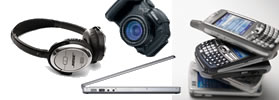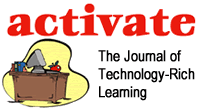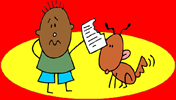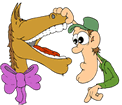Fall 2009 (volume 9, number 4)
The Quest for Content in a World of Google, Gadgets, and Graphics

Let’s teach young people the importance of deep understandings, critical thinking, and clear communication by matching quality content with effective technology for engaging learning experiences.
As Web 2.0 applications become commonplace, the line between technology consumers and creators is blurred. From the Kindle to the iphone, gadgets provide easy access to information. Digital cameras are tools for instantly sharing multimedia information with the world. The purpose of this session is to identify ways to create effective, efficient, and appealing learning environments that incorporate the best of what technology has to offer without losing the depth of thinking and richness of information that comes from authoritative content.
In a universe where googling is a pastime, gadgets fill our pockets, and graphics replace words, how will we teach young people the importance of deep understandings, critical thinking, and clear communication? The key is matching quality content with effective technology. Use technology-rich resources and experiences to provide a context for subject-area communication and collaboration. Help young people use technology to access, evaluate, apply, and create subject-area information across the curriculum. Apply quality content to meaningful learning contexts.
Updated Presentations for American Association of School Librarians
Get Graphic! Visuals for Deep Thinking, Inquiry, and Learning
Let’s Go! Google Earth and GIS Resources Across the Curriculum
Graphic Novels, Photo Essays & Illuminated Term Papers: Communicating Deep Understandings
Thinking Outside the Book: Doing More With Less in the Academic Library
 Facing tight budgets and growing demands, academic librarians are seeking ways to eliminate dated services, promote underused assets, and develop new services to meet changing needs. The key is thinking "outside the box"... and in the case of libraries, "beyond the book." The following three presentations explore ways that technology can be used to develop and promote effective, efficient, and appealing library communications, programs, and learning materials.
Facing tight budgets and growing demands, academic librarians are seeking ways to eliminate dated services, promote underused assets, and develop new services to meet changing needs. The key is thinking "outside the box"... and in the case of libraries, "beyond the book." The following three presentations explore ways that technology can be used to develop and promote effective, efficient, and appealing library communications, programs, and learning materials.
Recipes for Success: Information Age Approaches to Spice Up Your Academic Library Program
Sequential Art, Technology, and the Academic Library: Digital Comics and Graphic Novels Aren't Just for Kids
Get Graphic for Academic Librarians! Visual Tools and Resources for Deep Thinking, Inquiry, and Learning

 Reading, writing, information, and technology can rev up learning across the curriculum. Learn to integrate standards-based, technology-enhanced learning experiences; incorporate authentic, online primary source materials; and connect reading with web-based resources and activities including literature circles, wikis, collaborative projects, and blogs.
Reading, writing, information, and technology can rev up learning across the curriculum. Learn to integrate standards-based, technology-enhanced learning experiences; incorporate authentic, online primary source materials; and connect reading with web-based resources and activities including literature circles, wikis, collaborative projects, and blogs. As you explore subject area applications, consider the many ways Google tools can be used in teaching and learning.
As you explore subject area applications, consider the many ways Google tools can be used in teaching and learning. Learn to use technology tools and resources to promote graphic inquiry, collaboration, and communication to address technology and content-area standards. Young people are motivated by graphic communications. This visually rich workshop provides standards-based inquiry activities across grade levels and subject areas.
Learn to use technology tools and resources to promote graphic inquiry, collaboration, and communication to address technology and content-area standards. Young people are motivated by graphic communications. This visually rich workshop provides standards-based inquiry activities across grade levels and subject areas. From digital note-taking to online concept mapping, explore online tools and strategies that promote 21st century information and technology skills. Learn to integrate tools such as NoteStar and Diigo to help students take, organize and share notes for research projects. Integrate online concept map tools such as Gliffy and Webspiration. Explore online citation tools such as Noodle Tools and Citation Machine to develop bibliographies. Finally, explore the pros and cons of digital tools in K-12 research projects and issues in classroom management.
From digital note-taking to online concept mapping, explore online tools and strategies that promote 21st century information and technology skills. Learn to integrate tools such as NoteStar and Diigo to help students take, organize and share notes for research projects. Integrate online concept map tools such as Gliffy and Webspiration. Explore online citation tools such as Noodle Tools and Citation Machine to develop bibliographies. Finally, explore the pros and cons of digital tools in K-12 research projects and issues in classroom management.  Designed as an all-day or multiple day workshop, each part is also a stand-alone conference sesstion. Whether reading from a book or a website, nonfiction reading is a critical skill in developing information fluent thinkers. Exploration of nonfiction is a wonderful opportunity to motivate and facilitate curious minds. Life is messy. Involve students in activities that allow them to work with information and demonstrate their understandings.
Designed as an all-day or multiple day workshop, each part is also a stand-alone conference sesstion. Whether reading from a book or a website, nonfiction reading is a critical skill in developing information fluent thinkers. Exploration of nonfiction is a wonderful opportunity to motivate and facilitate curious minds. Life is messy. Involve students in activities that allow them to work with information and demonstrate their understandings.